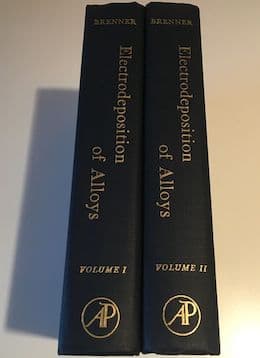
-----
Electrodeposition and Electroforming of Alloys
Q. Dear sir,
I am an engineering student currently involved in electroforming of alloys. I would like to know the parameters, bath composition and electrodes for electroforming of brass and bronze. Thanking you in advance.
Yours sincerely,
Pattabhiraman- Coimbatore, Tamilnadu, India
2002
A. Hi Pattabhiraman. Abner Brenner's classic "Electrodeposition of Alloys - Principle and Practice" is the first place to look for anything about alloy electrodeposition. Although brass and bronze are electrodepositable alloys, it is significantly more difficult to plate an alloy than a single metal; so, is there a really good reason you need brass or bronze rather than, say, copper or nickel?

Ted Mooney, P.E.
Striving to live Aloha
finishing.com - Pine Beach, New Jersey
Ted is available for instant help
or longer-term assistance.
2002
Q. I would like to know how alloys are plated.
Meesu [last name deleted for privacy by Editor]psg tech - Coimbatore, India
2006
A. Hi Meesu. Both (or all) the metals of the alloy are plated simultaneously rather than sequentially. For example a brass plating bath has copper and zinc in it, in proper concentrations, and with the copper heavily complexed so that it does not all plate out preferentially to the zinc as we might expect from the galvanic series. A sort of "stainless steel" has been produced on a laboratory basis, however, by plating hundreds of microlayers of nickel interspersed with microlayers of chrome.
Please tell us your actual situation, so we can understand the context of the question, and answer you better. Thanks!

Ted Mooney, P.E.
Striving to live Aloha
finishing.com - Pine Beach, New Jersey
Ted is available for instant help
or longer-term assistance.
2007
High copper alloy electrodeposition solution
Q. I am looking for solutions to electroplate high copper alloys, such as Cu-Cr (C182, using ASTM classification), Cu-Cr-Zr (C181500), or Cu-Ni-Si (C180).
In these materials, the alloying elements are only present in <2% weight composition and could be better described as "dopants". I am aware that some of the elements listed cannot be plated by traditional methods, but have read that they can be co-deposited under special circumstances.
Any information on commercial, or at least tested solutions for these alloys would be appreciated.
Best regards,
Olivier
- San Jose, California
May 25, 2016
by Abner Brenner

on eBay or Amazon
or AbeBooks
(affil link)
A. Hi Olivier. If you haven't yet seen Brenner's "Electrodeposition of Alloys", you might see if the San Jose library or a university library has a copy because it is the last word on electrodeposition of alloys. But even there I don't see similar alloys. Good luck.
Regards,

Ted Mooney, P.E. RET
Striving to live Aloha
finishing.com - Pine Beach, New Jersey
Ted is available for instant help
or longer-term assistance.
A. The San Jose State University library is excellent. They will likely have it.

Dave Wichern
Consultant - The Bronx, New York
May, 2016
![]() Thanks for your answer. I did consult the Brenner "bible", and, like you, found no directly relevant information. From the background sections I've read, such a process, if it at all exists, wouldn't be simple, because the standard electrode potentials of Cu and Cr are far apart. Zr, apparently, is even worse since the only known aqueous processes rely on "anomalous" co-deposition.
Thanks for your answer. I did consult the Brenner "bible", and, like you, found no directly relevant information. From the background sections I've read, such a process, if it at all exists, wouldn't be simple, because the standard electrode potentials of Cu and Cr are far apart. Zr, apparently, is even worse since the only known aqueous processes rely on "anomalous" co-deposition.
Olivier
- San Jose, California, USA
May 25, 2016
Q, A, or Comment on THIS thread -or- Start a NEW Thread